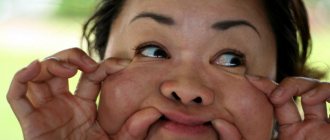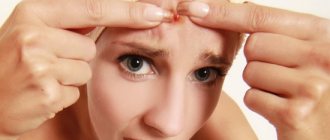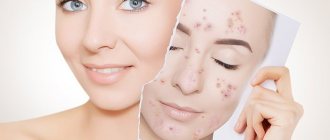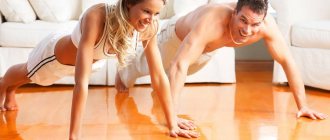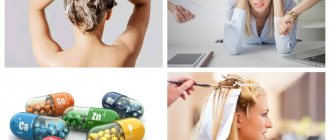What is acne
Acne is a closed inflammation that develops under the surface of the skin. They may look like:
- Papules are painful red bumps.
- Pustules are red bumps with a white abscess on top.
- Nodules are nodular formations that are hard to the touch and look like subcutaneous tubercles.
- Cysts are clusters of nodules.
Where do they come from?
- It all starts with comedones - this is what they call a mixture of dead skin particles, impurities and cosmetic residues that clog the sebaceous ducts.
- Inside the comedon, ideal conditions are created for the development of propionbacteria (they are the ones that provoke inflammation). This is, firstly, the lack of oxygen, and, secondly, the constant replenishment of sebum, which continues to be released and accumulate under the sebaceous plug.
- As a result, bacteria multiply and provoke inflammation - this is how acne appears. They are often called “closed comedones” precisely because all the processes occur below the surface of the skin.
Types of imperfections on the face
In addition to acne, there are other types of inflammation, but all of them are somehow associated with blockage of the sebaceous ducts and/or increased sebum production. What is the difference?
Acne
One pimple is not yet acne. But if they spread all over the face and clump together... This means that we are not talking about a one-time inflammation, but about a serious disease that needs to be treated with the support of specialists - a dermatologist, gynecologist, endocrinologist, cosmetologist and gastroenterologist. If acne is started or treated incorrectly, scars and scars may remain on the skin - post-acne.
Black dots
Blackheads are called “open comedones.” The mechanism of their occurrence is the same as that of acne, but the process occurs not under the skin, but on its surface. By the way, blackheads do not become black because of a large amount of dirt: the reason is the oxidative process that occurs when the sebaceous plug and oxygen interact.
Acne
Essentially, blackheads are blackheads that were not removed in time (we have already mentioned that a mixture of sebum and pollution is an ideal environment for the development of bacteria). If you notice acne on your face, do not peel under any circumstances! During the process of exfoliation, you can spread bacteria all over your face and cause acne.
How to get rid of the effects of acne?
Smoothing scars depends on the type of defect, since they differ from each other and arise for different reasons. And here it is very important to find the optimal treatment in each individual case. Therefore, it is important to seek help from a cosmetologist. It happens that a person got rid of one pimple quite successfully, but it will not be possible to remove another scar using the same method.
Keloid scars appear when the immune system is low. They are distinguished by a wrinkled surface, elastic, uneven consistency. In addition, they are located significantly higher than the skin. They continue to grow and resemble warts in appearance. Such irregularities can be removed through surgery.
However, additional treatment methods must be used at the same time. Because surgery can lead to new scars and scars.
Causes of acne on the face
Contrary to stereotypes, acne (both small and large) does not only affect teenagers. Nasty lumps can occur in women and men at any age, even infancy! Why does the skin suddenly begin to “bloom”?
Among women
- Hormonal disbalance. Hormones can go crazy, for example, during pregnancy or menopause.
- Genetic predisposition. Most often, acne affects those with oily or combination skin types, which are known to be inherited.
- Poor nutrition. “Dangerous trinity” - flour, fatty, sweet. Try removing it from your diet, and your face will become noticeably cleaner!
- Incorrect care. The main stages of caring for problem skin include cleansing, deep cleansing (exfoliation), makeup removal, toning and moisturizing. You can't miss any of them! At the same time, the composition of cosmetics must contain sebum-regulating and bactericidal components: zinc, salicylic acid, eucalyptus or black elderberry extract, activated carbon, clay, etc.
- Digestive problems. A gastrointestinal disorder can lead to an imbalance of intestinal microflora and the accumulation of toxins that negatively affect the condition of the skin.
- Stress. At the most inopportune moment, a pimple popped up in a visible place? The law of meanness has nothing to do with it: it’s just that the stress hormone cortisol also affects sebum production.
- Bad habits. These are, first of all, smoking, alcohol, poor drinking habits and sleepless nights.
In men
- Lack of care or improper care. Due to the large number of sebaceous glands, men's skin almost always suffers from oiliness. Add to this the abundance of testosterone, which stimulates sebum production, and you will have no questions left about where men get acne.
- Shaving. If bacteria get into the wound after shaving, inflammation is not far off.
In children and adolescents
- Hormonal disbalance. During puberty, adolescents begin to undergo global hormonal changes, and the level of testosterone and dihydrotestosterone production increases. And they, in turn, provoke excessive secretion of sebum. Voila, here you have acne! Most often, inflammation in adolescence occurs in the T-zone: this is where most of the sebaceous glands are located.
- Infant acne. The appearance of pimples on the face of infants is associated with imperfections in the excretory system and an excess of maternal hormones. There is no need to treat them: if hygiene standards are observed, they will go away quite quickly on their own.
Traditional methods
You can remove pimples at home using products available in any home medicine cabinet. The process of dealing with an irritant is conventionally divided into two stages.
The first thing efforts are directed towards is relieving inflammation. The second stage is characterized by treating the area for the purpose of drying and healing:
- Aspirin is a popular anti-inflammatory drug. To carry out the procedure, 2 tablets must be thoroughly crushed and achieved a mushy consistency by adding a few drops of water. Apply to the affected area 3-4 times a day.
- Tea tree oil is excellent at relieving inflammation. It should be applied undiluted with a cotton swab 3 times a day.
- Aloe juice is used in the form of compresses. For the procedure, just cut a small piece of a twig in half lengthwise and apply the inside to the problem area. It is more effective to apply a compress at night, securing the plant with a band-aid.
- A decoction of chamomile, calendula or sage is a worthy alternative to aspirin. Lotions relieve inflammation, remove redness, and dry the skin. Preparation of the decoction: 2 tablespoons of the dry plant are poured with a quarter glass of boiling water. The herb is infused for 40 minutes. Lotions are made using a cotton pad.
- Tar soap is actively used in the fight against acne. To do this, you need to soap your hands with warm water and wash your face with foam. You need to repeat the procedure twice a day. You can also apply soap pointwise, directly to the affected area. Another option is often used to cleanse the face. Apply soap foam to the face and leave for 15 minutes. After which it is washed off with warm water.
- Cucumber masks effectively dry out inflamed areas and promote rapid healing. It is enough to carry out daily procedures until the lesions completely disappear.
- Alcohol tinctures of calendula, sage, and zinc ointment quickly heal wounds and relieve redness. You need to wipe acne with tinctures 3-4 times a day. And zinc ointment is rubbed in for deep penetration twice a day.
- Oatmeal, preferably crushed, and vegetable oil, taken in a 1:1 ratio, are applied to the problem area. After 40 minutes, the mixture is removed with a damp cotton pad. The procedure must be repeated after 1.5 hours.
How to properly remove pimples from your face
To remove acne from your face at home, it is important to remember and follow three important beauty rules.
RULE No. 1
Do not squeeze out red inflammation!
First, let the pimple “mature” and draw up a comprehensive plan to destroy the enemy. RULE No. 2
Provide your skin with proper care:
- Cleansing. Look for gels and foams with sebum-regulating and bactericidal components. Makeup remover products should have an oil-free base.
- Deep cleansing. Do not use scrubs during periods of exacerbation. If your skin is often inflamed, try creams with acids that will provide the most gentle exfoliation.
- Toning. Tonic will help wash away any remaining impurities and makeup, cleanse pores and prepare the skin for the next stage of your beauty routine.
- Hydration. If your facial skin is dehydrated, the sebaceous glands begin to secrete even more sebum, so be sure to moisturize your skin. Must have in the composition is hyaluronic acid.
- Additional care. Two or three times a week, pamper your skin with masks with a mattifying effect: for example, based on clay or activated carbon.
RULE No. 3
If acne covers your entire face and has spread to your shoulders and chest, be sure to consult a cosmetologist!
Is it possible to get rid of acne quickly?
What to do if you need to get rid of hated acne as soon as possible? We reveal the most effective methods of care!
How to get rid of acne on your face in a week
A week is enough time to develop a program to combat acne together with a cosmetologist!
- CARE Use home care cosmetics for problematic facial skin. It is less traumatic than, for example, salicylic acid in its pure form. And don't forget about hydration - this is the foundation!
- HYGIENE Wash your face twice a day with gel or foam and dry your face with paper towels. Fabrics can be carriers of bacteria.
- TESTS Get tested for hormones, as well as general and biochemical blood tests. Discuss them with your cosmetologist.
How to get rid of a pimple in an hour
For emergency cases, this option is optimal: you need to take eye drops, moisten a cotton pad with them and put it in the freezer for 1 minute to cool. Apply the tampon with the medicine to the pimple for 5 minutes. Visible redness and external inflammation will become almost invisible. This effect is due to the fact that eye drops narrow the capillaries well. Unfortunately, this method has a temporary effect and lasts only 5-6 hours.
Sometimes ordinary salt is used for treatment. For 1 tsp. salts, take the same amount of water and make a compress from a napkin. The paper should dry directly on the skin, while the salt draws out water, relieves swelling and dries the skin.
The use of aloe also gives good results, but only if the redness has already passed and only a tubercle remains at the site of the pimple. A freshly picked leaf of the plant is cut into two parts and the pulp is applied to the tubercle. The structure can be secured on top with adhesive tape. After 5 hours, the leaf can be removed and compared “before” and “after”.
Prevention measures
Nutrition greatly affects the condition of the skin. For this reason, a week before an important event, it is advisable to exclude spicy, salty, fatty and sweet foods from their diet. This will help reduce the risk of rashes and inflammation.
Before an important event, it is rare that a person is not nervous and worried. This directly affects the condition of the skin: due to the release of an increased amount of hormones, the sebaceous glands begin to produce sebum in excess, which often clogs the pores. As a result of this, acne appears. Therefore, even before serious and responsible events, it is better to try to remain calm and positive, so that later you do not rack your brains over the question of how to get rid of acne overnight.
You also need to take proper care of your face. Mistakes in this matter can cause deep acne to appear at the most unexpected moment. The skin must be thoroughly cleansed in the morning and evening, and deep cleansed once a week. Even if the proposed methods do not help to completely get rid of acne on the forehead or cheeks, you should not be upset. The effect will be the same, since these methods help reduce the intensity of inflammation, so it will be much easier to tone such skin with cream or powder.
How to get rid of acne at home using cosmetics
To get rid of acne forever, stock up not only with patience, but also with a decent arsenal of skincare products with sebum-regulating, exfoliating and anti-inflammatory ingredients. The minimum program is a gel or foam cleanser, makeup remover, toner, scrub and face mask.
How to remove a pimple on your face
If you need to get rid of acne on your face in 2-3 days, zinc ointment and Levomekol will come to the rescue. These drugs have a good anti-inflammatory effect. But if Levomekol can be applied to a pimple constantly throughout the day, then zinc ointment can only be applied from time to time.
To combat the inflammatory process, you can use the following means:
- salicylic acid;
- lemon juice;
- tea tree oil.
These substances are applied pointwise to areas of inflammation. With regular application, the intensity of the inflammatory process is significantly reduced. After this, the task is to remove redness and residual manifestations. For this you can use lavender oil, toothpaste, garlic.
